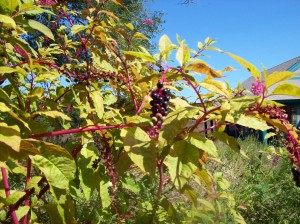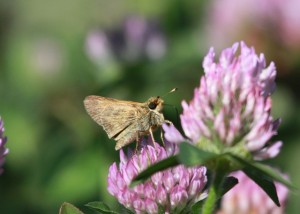The next time you’re mowing, weed-whacking or otherwise ridding your yard of unwanted plants, take a closer look. Some of them may produce a lot of food and habitat for wildlife.
This is not to say you shouldn’t guard against invasive species, such as spotted knapweed, multiflora rose or Asian bittersweet.
But consider the ubiquitous pokeweed, a native plant that probably will never win a prize at a flower show. As science coordinator Mark Faherty points out, pokeweed provides a late summer feast for lots of birds (though its berries are toxic to people and pets).
“I remember one fall day watching 6 Baltimore orioles, multiple flickers, a flock of bluebirds, 11 cedar waxwings, a flock of robins, and some other birds all fighting over a single pokeweed in James Nielsen’s yard,” Mark says. “The bluebirds always strip the (pokeweed) plant just outside the staff entrance.”
Insects, including important pollinators like bees, butterflies, and moths, also use weedy plants. Lowly crabgrass is a host for the Sachem butterfly, a species that has colonized Massachusetts from the south just in the last three years.
And you never know when what seems like an anonymous little plant can become important.
“The Baltimore checkerspot (butterfly),” Mark says, “used to rely mainly on the uncommon wetland plant white turtlehead for its egg and larval stages. But over the past 30 years, it’s been using what is essentially a lawn weed – a non-native called lance-leaved or English plantain.” The butterfly’s switch to this new host plant has contributed to a surge in its population in
Massachusetts.
Our resident plant expert Dennis Murley suggests some other “weeds” that provide a lot of food for wildlife, though he says in some cases it’s not clear if birds are drawn by seeds or insects feasting on the plant:
- Virginia creeper (native, fruit)
- evening primrose (native, seeds)
- smartweed (native, seeds)
- ragweed (native, seeds and insects)
- Queen Anne’s lace (non-native, hostplant for black swallowtail and nectar source for pollinators)






The pokeweed link is broken